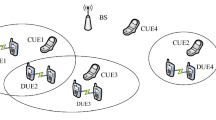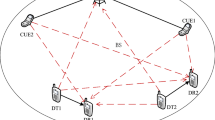Abstract
This paper addresses the problem of joint resource block (RB) and uplink transmission power allocation in a Device to Device (D2D) underlay cellular network via a game theoretic approach. In contrast to the majority of previous research works in this area, the proposed framework aims mainly at interference mitigation and energy efficiency. We do not restrict a priori the number of D2D pairs which can reuse a RB allocated to a cellular link. However, this is determined dynamically by the objective of interference minimization. To address the resource allocation problem under consideration and deal with its inherent complexity, a two-step distributed approach is proposed. At first the RB allocation process is modeled as an exact potential game which is shown to minimize the total interference in the network. Second a non-cooperative game theoretic model for the uplink transmission power allocation process is proposed. For both stages of the proposed framework, efficient and distributed algorithms for the computation of the desired Nash Equilibrium (NE) point of each game are introduced. The efficiency of the overall proposed framework is evaluated through modeling and simulation, while comparative numerical results are presented that demonstrate the superiority of our methodology against other state of the art approaches.











Similar content being viewed by others
References
Osseiran A, Boccardi F, Braun V et al (2014) Scenarios for 5G mobile and wireless communications: the vision of the metis project. IEEE Commun Mag 52:26–35
Chen S, Zhao J (2014) The requirements, challenges, and technologies for 5G of terrestrial mobile telecommunication. IEEE Commun Mag 52:36–43
Nam W, Bai D, Lee J, Kang I (2014) Advanced interference management for 5G cellular networks. IEEE Commun Mag 52:52–60
Da Silva I et al (2016) 5G RAN architecture and functional design. 5G PPP METIS-II White Paper. https://metis-ii.5g-ppp.eu/wp-content/uploads/5G-PPP-METIS-II-5G-RAN-Architecture-White-Paper.pdf. Accessed 13 May 2016
Tehrani MN, Uysal M, Yanikomeroglu H (2014) Device-to-device communication in 5G cellular networks: challenges, solutions, and future directions. IEEE Commun Mag 52:86–92
3GPP TR 36.843, V12.0.1 (2014) Study on LTE device to device proximity services; radio aspects. http://www.3gpp.org/ftp/Specs/archive/36_series/36.843/36843-c01.zip. Accessed 13 May 2016
Asadi A, Wang Q, Mancuso V (2014) A survey on device-to-device communication in cellular networks. IEEE Commun Surv Tutor 16:1801–1819
Feng D, Lu L, Yuan-Wu Y, Ye Li G, Li S, Feng G (2014) Device-to-device communications in cellular networks. IEEE Commun Mag 52:49–55
Fodor G, Dahlman E, Mildh G, Parkvall S, Reider N, Miklós G, Turányi Z (2012) Design aspects of network assisted device-to-device communications. IEEE Commun Mag 50:170–177
Wei L, Hu RQ, Qian Y, Wu G (2014) Enable device-to-device communications underlaying cellular networks: challenges and research aspects. IEEE Commun Mag 52:90–96
Doppler K, Yu CH, Ribeiro CB, Jänis P (2010) Mode selection for device-to-device communication underlaying an LTE-advanced network. IEEE Wireless Commun Netw Conf, 1–6
Phunchongharn P, Hossain E, Dong KI (2013) Resource allocation for device-to-device communications underlaying LTE-advanced networks. IEEE Trans Wirel Commun 20:91–100
Yu CH, Doppler K, Ribeiro C, Tirkkonen O (2011) Resource sharing optimization for device-to-device communication underlaying cellular networks. IEEE Trans Wirel Commun 10:2752–2763
Wang J, Zhu D, Zhao C, Li JCF, Lei M (2013) Resource sharing of underlaying device-to-device and uplink cellular communications. IEEE Commun Lett 17:1148–1151
Zulhasnine M, Huang C, Srinivasan A (2010) Efficient resource allocation for device-to-device communication underlaying LTE network. IEEE 6th Int Conf Wireless Mobile Comput, Netw Commun (WiMob), 368–375
Feng D, Lu L, Yuan-Wu Y, Li GY, Feng G, Li S (2013) Device-to-device communications underlaying cellular networks. IEEE Trans Commun 61:3541–3551
Papadimitriou C, Steiglitz K (1998) Combinatorial optimization: algorithms and complexity. Dover Publications
Colell M, Whinston MD, Green JR (1995) Microeconomic theory. Oxford University Press
Hasan M, Hossain E (2014) Distributed resource allocation in 5G cellular networks, arXiv preprint arXiv:1409.2475
Neel JOD (2006) Analysis and design of cognitive radio networks and distributed radio resource management algorithms. Dissertation, Virginia Polytechnic Institute and State University
Chen X, Hu RQ, Qian Y (2014) Distributed resource and power allocation for device-to-device communications underlaying cellular network. IEEE Global Commun Conf (GLOBECOM), 4947–4952
Yin R, Yu G, Zhang H, Zhang Z, Li YG (2015) Pricing-based interference coordination for D2D communications in cellular networks. IEEE Trans Wirel Commun 14:1519–1532
Xu C, Song L, Han Z, Zhao Q, Wang X, Cheng X, Jiao B (2013) Efficiency resource allocation for device-to-device underlay communication systems: a reverse iterative combinatorial auction based approach. IEEE J Select Area Commun 31:348–358
Wang F, Xu C, Song L, Han Z (2015) Energy-efficient resource allocation for device-to-device underlay communication. IEEE Trans Wirel Commun 14:2082–2092
Yin R, Zhong C, Yu G, Zhang Z et al (2015) Joint spectrum and power allocation for D2D communications underlaying cellular networks. IEEE Trans Veh Technol 65:2182–2195
3GPP TS 36.211, Rel. 12 (2016) Evolved Universal Terrestrial Radio Access (E-UTRA); Physical channels and modulation. http://www.etsi.org/deliver/etsi_ts/136200_136299/136211/12.08.00_60/ts_136211v120800p.pdf Accessed 13 May 2016
Fudenberg D, Tirole J (1991) Game theory. MIT Press, Cambridge
Monderer D, Shapley LS (1996) Potential games. Games and Economic Behavior 14:124–143
Yannakakis M (2009) Equilibria, fixed points, and complexity classes. Comput Sci Rev 3:71–85
Chien S, Sinclair A (2007) Convergence to approximate Nash equilibria in congestion games. 18th annual ACM-SIAM symposium on Discrete algorithms. Soci Indust Appl Math, 169–178
Yates RD (1995) A framework for uplink power control in cellular radio systems. IEEE J Select Areas Commun 13:1341–1347
Wen S, Zhu X, Lin Z, Zhang X, Yang D (2013) Distributed resource management for Device-to-Device (D2D) communication underlay cellular networks. IEEE 24th Int Symp Personal, Indoor Mobile Radio Commun, 1624–1628
Author information
Authors and Affiliations
Corresponding author
Appendix I
Appendix I
1.1 Proof of Lemma 1
The potential function of game G can be written as:
Let \( Q\left({s}_{-i}\right)={\displaystyle \sum_{k\ne i,k=1}^N\Big[-a{\displaystyle \sum_{j\ne k,j\ne i,j=1}^N{p}_j{G}_{jk}f\left({c}_j,{c}_k\right)}-}\left(1-a\right){\displaystyle \sum_{j\ne i,j\ne k,j=1}^N{p}_k{G}_{kj}f\left({c}_k,{c}_j\right)\left)\right]} \) Then: \( \begin{array}{l} Pot\left({s}_i,{s}_{-i}\right)=-a{\displaystyle \sum_{j\ne i,j=1}^N{p}_j{G}_{ji}f\left({c}_j,{c}_i\right)}-\left(1-a\right){\displaystyle \sum_{j\ne i,j=1}^N{p}_i{G}_{ij}f\left({c}_i,{c}_j\right)\sum_{k\ne i,k=1}^N\Big[-a{p}_i{G}_{ik}f\left({c}_i,{c}_k\right)-}\left(1-a\right){p}_k{G}_{ki}f\left({c}_k,{c}_i\right)\Big]+Q\left({s}_{-i}\right)=-\left(a+\left(1-a\right)\right){\displaystyle \sum_{j\ne i,j=1}^N{p}_j{G}_{ji}f\left({c}_j,{c}_i\right)}-\left(\left(1-a\right)+a\right){\displaystyle \sum_{j\ne i,j=1}^N{p}_i{G}_{ij}f\left({c}_i,{c}_j\right)}\\ {}+Q\left({s}_{-i}\right)=-{\displaystyle \sum_{j\ne i,j=1}^N{p}_j{G}_{ji}f\left({c}_j,{c}_i\right)}-{\displaystyle \sum_{j\ne i,j=1}^N{p}_i{G}_{ij}f\left({c}_i,{c}_j\right)}+Q\left({s}_{-i}\right)\end{array} \)
If link i changes strategy from s i to s ' i then from (9) we have
Then follows:
The above formulated game G is an exact potential game with the exact potential function Pot(s i , s − i ). ■
Rights and permissions
About this article
Cite this article
Katsinis, G., Tsiropoulou, E.E. & Papavassiliou, S. Joint Resource Block and Power Allocation for Interference Management in Device to Device Underlay Cellular Networks: A Game Theoretic Approach. Mobile Netw Appl 22, 539–551 (2017). https://doi.org/10.1007/s11036-016-0764-y
Published:
Issue Date:
DOI: https://doi.org/10.1007/s11036-016-0764-y




